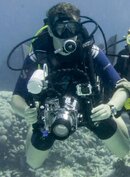CaptainHornblower
Registered
A couple of weeks ago a friend and I changed the propellers on a friends boat while it was in the water. Since it was shallow enough that I could almost stand on the bottom (turns out, not quite) I thought I'd be better off without fins. It all worked out fine, but I was really surprised that I could barely make any headway when I tried to swim with full gear on but no fins. I bet I couldn't swim more than a tenth of a mph using both legs and arms.
The experience highlighted to me just how "un-steamlined" I had to be with all the gear on. Thus my question: has anyone ever come up with anything to improve efficiency with scuba gear on?
The experience highlighted to me just how "un-steamlined" I had to be with all the gear on. Thus my question: has anyone ever come up with anything to improve efficiency with scuba gear on?






